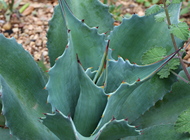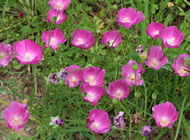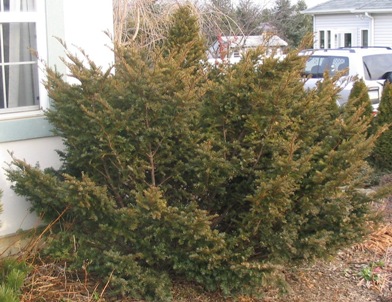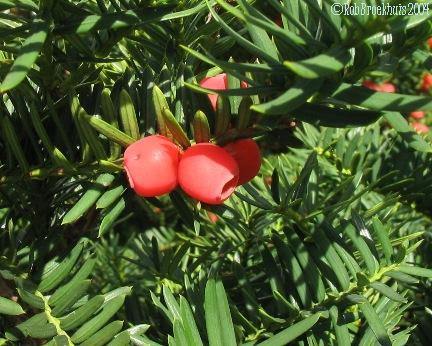 |
Taxus cuspidata 'Capitata' |
 |
| Common name |
pyramidal yew; clipped yew |
| Family |
taxaceae |
| Life cycle |
shrub |
| Size |
6' |
| Light |
sun-part shade |
| Cultural notes |
ordinary garden soil |
We bought this one labeled 'Pyramidal yew' a long time ago. I believe I've got it correctly identified, but please set me straight if you believe otherwise. Although most yews get clipped and formed, we allow ours to assume its natural form - which is an elegantly cascading blob. It's a very useful evergreen, never looking ratty, and has ornamental red berries in late summer and fall. So we're not a bit apologetic about growing this traditional "foundation shrub" along - you guessed it - the front of our house.
|

| | Providing green in winter |
|
We left this plant behind in our Pennsylvania garden (and wish it well); we don't grow it in Houston. About my plant portraits
PlantLinks to other web pages about Taxus cuspidata 'Capitata'
Visitors to this page have left the following comments| Marsha S. Clesceri | Oct 16, 2005 | Rob, It is my understanding that T. cuspidata 'Capitata' is a male cultivar and would not have fruit.
Thanks, Marsha. I couldn't find references online to the male/female status of this cultivar - this page addresses the dioecious nature of the species, without assigning a gender to the 'Capitata' cultivar. I'll leave it as an open question for now. |
| Cheri | Dec 13, 2008 | I love yews however they are toxic, needles more so than the berries. |
| Cheri | Dec 13, 2008 | I love yews however they are toxic, needles more so than the berries. |
| Adam | Mar 06, 2010 | The plant may be toxic but has created many remedies in medicine and also the berries are edilble just not the seed. As for the correct genus and speices thats harder to indentify but i do believe you do have the correct name but cultivars are very tricky. go back to the nursery if you are really curious they can probabily tell you the cultivars they carry. |
| Laura | May 19, 2010 | Taxus cuspidata 'Capitata' is propagated via seed. The male seeds will develop into plants which do not produce berries while the female seeds will become plants that can produce berries if they are pollinated by a male. When I was a child, I lived in a home which had two pyramidal yews. One was a male and the other was a berry producing female. |
I welcome comments about my web pages; feel free to use the form below to
leave feedback about this particular page. For the benefit of other visitors
to these pages, I will list any relevant comments you leave, and if
appropriate, I will update my page to correct mis-information. Faced with an
ever-increasing onslaught of spam, I'm forced to discard any comments including
html markups. Please submit your comment as plain text. If you have a
comment about the website as a whole, please leave it in my
guestbook. If you
have a question that needs a personal response, please
e-mail me.
Last modified:
January 22, 2005
Contact me
|



